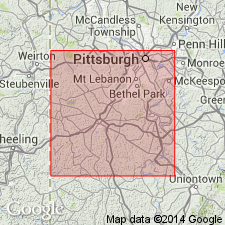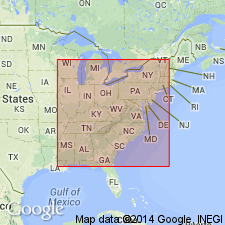
- Usage in publication:
-
- Pittsburgh Formation*
- Modifications:
-
- Revised
- Redescribed
- Reference
- Dominant lithology:
-
- Sandstone
- Limestone
- Siltstone
- Clay
- AAPG geologic province:
-
- Appalachian basin
Summary:
The name "Pittsburgh" has previously been applied to several thin lithologic units. Use of Pittsburgh for multiple units within Monongahela or Conemaugh Formations is here discontinued; Pittsburgh Formation of Monongahela Group replaces those units. Reference section is just west of Elco, California quad, Washington Co., PA, along north bank of Monongahela River and in road cuts of PA Hwy 88. Pittsburgh Formation is a cyclic sequence of fresh-water limestone beds and clay beds occupying most of the intervals between coal beds. Includes sequence of beds 230 to 250 ft thick, extending from base of Pittsburgh coal bed to base of Uniontown coal bed, or to top of brecciated limestone beneath coal horizon in areas where Uniontown coal is represented by carbonaceous shale or clay. Includes five members (ascending): a lower unnamed member, Redstone, Fishpot, and Sewickley Members (named after basal coal beds in each unit), and an upper unnamed member. Sewickley Member contains Benwood Limestone Bed, 45 to 60 ft thick. Farther west, in Washington Co., PA, in panhandle area of WV, and in east-central OH, limestone beds extend down to Pittsburgh coal. Upper unnamed member is characterized by several persistent greenish siltstone layers of which the lowest is most conspicuous. At the section at Elco, two lowest siltstone layers merge to form a greenish massive siltstone. Age is Late Pennsylvanian. Report includes stratigraphic section.
Source: GNU records (USGS DDS-6; Reston GNULEX).

- Usage in publication:
-
- Pittsburgh Formation*
- Modifications:
-
- Overview
- AAPG geologic province:
-
- Appalachian basin
Summary:
Pittsburgh Formation is used only in PA in lower part of Monongahela Group. Name used for two cyclothems in OH. Includes mudstone, siltstone, sandstone, limestone, and minor coal between bases of Pittsburgh and Uniontown coals. Includes Sewickley, Fishpot, and Redstone Members; in OH, these members are treated as cyclothems.
Source: GNU records (USGS DDS-6; Reston GNULEX).
For more information, please contact Nancy Stamm, Geologic Names Committee Secretary.
Asterisk (*) indicates published by U.S. Geological Survey authors.
"No current usage" (†) implies that a name has been abandoned or has fallen into disuse. Former usage and, if known, replacement name given in parentheses ( ).
Slash (/) indicates name conflicts with nomenclatural guidelines (CSN, 1933; ACSN, 1961, 1970; NACSN, 1983, 2005, 2021). May be explained within brackets ([ ]).

